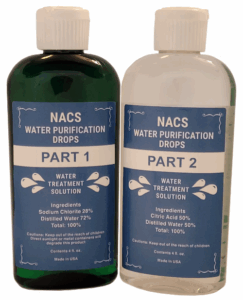As the world faces a looming health crisis triggered by the increasing failure of conventional antibiotics, a simple, inexpensive, and unpatentable solution is quietly gaining attention: chlorine dioxide. Unlike conventional antibiotics, which target specific bacteria or strains, chlorine dioxide (ClO₂) operates as a broad-spectrum antimicrobial agent with a unique mechanism that pathogens cannot easily resist. Its chemical structure and oxidative function make it a formidable line of defense against bacteria, viruses, fungi, and even parasites, including parasitic worms.
The Superbug Crisis
A 2024 report from the National Institute of Allergies and Infectious Diseases (NIAID) highlights a chilling truth: antimicrobial resistance is not just a future possibility; it is already here. Diseases such as tuberculosis, gonorrhea, malaria, and pneumonia, once easily treatable with antibiotics, are becoming nearly impossible to control due to drug-resistant strains. The World Health Organization (WHO) and the Centers for Disease Control and Prevention (CDC) have also identified antimicrobial resistance (AMR) as one of the top global public health threats.
Hospitals have become hotbeds for drug-resistant microbes, including Methicillin-resistant Staphylococcus aureus (MRSA) and Vancomycin-resistant Enterococci (VRE). New strains of Streptococcus pneumoniae, which cause meningitis and pneumonia, are resisting not just penicillin, but multiple classes of antibiotics. Similarly, multidrug-resistant tuberculosis (MDR-TB) continues to threaten those with weakened immune systems, especially individuals with HIV/AIDS.
Despite rising mortality and healthcare costs, estimated at up to $30 billion annually in the United States alone, the pharmaceutical industry is struggling to develop new antibiotic classes at a rate that is too slow to keep pace with microbial evolution.
Why Microbes Can’t Outsmart Chlorine Dioxide
Unlike traditional antibiotics that interfere with specific metabolic pathways or protein structures in microorganisms (which microbes can mutate to bypass), chlorine dioxide works by oxidation; it denatures proteins and disrupts microbial cell walls through a process that is non-specific and purely chemical. This oxidative stress is lethal to pathogens but leaves beneficial flora and human cells untouched when appropriately used at therapeutic levels.
Several studies support this mechanism:
- Ogata & Shibata (2008) demonstrated that ClO₂ gas disrupted viral RNA replication, suggesting effectiveness against viruses.
- Georgiou and Kotzé (2022) confirmed chlorine dioxide’s ability to eradicate MRSA, the infamous hospital superbug.
- Ma et al. (2017) and researchers from the University of Almería (2020) reported no toxicity in therapeutic doses of ClO₂, reinforcing its safety profile for human use.
What makes ClO₂ particularly unique is that it does not contribute to the creation of resistant strains. Unlike antibiotics that act by poisoning invaders, thus encouraging mutation, ClO₂ eliminates invaders by oxidative damage that they cannot adapt to or neutralize.
ClO₂: Broad-Spectrum Without Collateral Damage
Most antibiotics are designed to target narrow therapeutic windows. For example, a prescription for a urinary tract infection may kill the pathogen, along with beneficial gut flora, potentially causing additional problems such as yeast infections or digestive issues. Chlorine dioxide, on the other hand, targets harmful pathogens while sparing healthy cells and beneficial bacteria when used responsibly.
Additionally, chlorine dioxide has been reported by practitioners and alternative health researchers to effectively address a wide range of infections and infestations, including:
- Bacterial infections (e.g., Staphylococcus, Streptococcus, Salmonella)
- Viruses (e.g., HIV, Influenza, Coronaviruses)
- Parasites (e.g., Giardia, Entamoeba, Helminths)
- Fungi (e.g., Candida albicans)
Unlike modern antibiotics, which are expensive to develop, manufacture, and patent, chlorine dioxide is inexpensive to produce and cannot be patented in its basic form. This lack of commercial profitability has led to little to no motivation from pharmaceutical companies to promote or further study it, despite its promising results.
A Public Health Tool, Not a Patentable Pill
In an era where lifesaving solutions are often driven by profitability, chlorine dioxide represents a threat to the medical-industrial complex rather than an asset. Because it’s a simple molecule with a century-long history of use in water purification, ClO₂ doesn’t fit into the business model of expensive treatments and exclusive patents. Yet its impact, when properly understood and applied, could be revolutionary in the global fight against drug-resistant infections.
As health systems continue to struggle with emerging superbugs and ineffective pharmaceuticals, it may be time to revisit this low-cost, high-impact, unpatentable ally that offers something rare in modern medicine: hope without a high price tag.
References
- NIAID. “Antimicrobial Resistance Fact Sheet.” National Institute of Allergies & Infectious Diseases, National Institutes of Health. https://www.niaid.nih.gov/research/antimicrobial-resistance
- Georgiou, G., & Kotzé, D. (2022). Chlorine Dioxide: An Effective Antimicrobial Agent Against MRSA. Journal of Bacteriology & Mycology: Open Access.
- Humble, Paris (2022) Healthy Alternative Chlorine Dioxide Uses: Non-Pharmaceutical Health Restoration
- Kalcker, A. L. (2020). Forbidden Health: The Science and Practice of Chlorine Dioxide.
- University of Almería. (2020). Evaluation of CDS for Human Health Applications. Internal Study (unpublished public summary).
- Ma, J., Huang, Q., & Zhao, Y. (2017). The Safety Evaluation of Oral Chlorine Dioxide. Toxicology Letters, 280, S226.
- Ogata, N., & Shibata, T. (2008). Protective effect of low-concentration chlorine dioxide gas against influenza A virus infection. Journal of General Virology, 89(1), 60–67.

